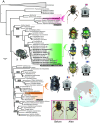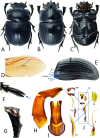From museum drawer to tree: Historical DNA phylogenomics clarifies the systematics of rare dung beetles (Coleoptera: Scarabaeinae) from museum collections
- PMID: 39739893
- PMCID: PMC11687894
- DOI: 10.1371/journal.pone.0309596
From museum drawer to tree: Historical DNA phylogenomics clarifies the systematics of rare dung beetles (Coleoptera: Scarabaeinae) from museum collections
Abstract
Although several methods exist for extracting and sequencing historical DNA originating from dry-preserved insect specimens deposited in natural history museums, no consensus exists as to what is the optimal approach. We demonstrate that a customized, low-cost archival DNA extraction protocol (∼€10 per sample), in combination with Ultraconserved Elements (UCEs), is an effective tool for insect phylogenomic studies. We successfully tested our approach by sequencing DNA from scarab dung beetles preserved in both wet and dry collections, including unique primary type and rare historical specimens from internationally important natural history museums in London, Paris and Helsinki. The focal specimens comprised of enigmatic dung beetle genera (Nesosisyphus, Onychothecus and Helictopleurus) and varied in age and preservation. The oldest specimen, the holotype of the now possibly extinct Mauritian endemic Nesosisyphus rotundatus, was collected in 1944. We obtained high-quality DNA from all studied specimens to enable the generation of a UCE-based dataset that revealed an insightful and well-supported phylogenetic tree of dung beetles. The resulting phylogeny propounded the reclassification of Onychothecus (previously incertae sedis) within the tribe Coprini. Our approach demonstrates the feasibility and effectiveness of combining DNA data from historic and recent museum specimens to provide novel insights. The proposed archival DNA protocol is available at DOI 10.17504/protocols.io.81wgbybqyvpk/v3.
Copyright: © 2024 Lopes et al. This is an open access article distributed under the terms of the Creative Commons Attribution License, which permits unrestricted use, distribution, and reproduction in any medium, provided the original author and source are credited.
Conflict of interest statement
The authors have declared that no competing interests exist.
Figures



Similar articles
-
Sequence capture phylogenomics of historical ethanol-preserved museum specimens: Unlocking the rest of the vault.Mol Ecol Resour. 2019 Nov;19(6):1531-1544. doi: 10.1111/1755-0998.13072. Epub 2019 Sep 18. Mol Ecol Resour. 2019. PMID: 31448547
-
Multigene phylogenetic analysis redefines dung beetles relationships and classification (Coleoptera: Scarabaeidae: Scarabaeinae).BMC Evol Biol. 2016 Nov 29;16(1):257. doi: 10.1186/s12862-016-0822-x. BMC Evol Biol. 2016. PMID: 27899070 Free PMC article.
-
Sequence capture of ultraconserved elements from bird museum specimens.Mol Ecol Resour. 2016 Sep;16(5):1189-203. doi: 10.1111/1755-0998.12466. Epub 2015 Oct 24. Mol Ecol Resour. 2016. PMID: 26391430
-
Analysis of DNA from natural history museum collections.EXS. 1994;69:311-21. doi: 10.1007/978-3-0348-7527-1_19. EXS. 1994. PMID: 7994112 Review.
-
Mining museums for historical DNA: advances and challenges in museomics.Trends Ecol Evol. 2021 Nov;36(11):1049-1060. doi: 10.1016/j.tree.2021.07.009. Epub 2021 Aug 26. Trends Ecol Evol. 2021. PMID: 34456066 Review.
References
-
- Fong JJ, Blom MP, Aowphol A, McGuire JA, Sutcharit C, Soltis PS. Recent advances in museomics: revolutionizing biodiversity research. Frontiers in Ecology and Evolution. 2023;11:349. doi: 10.3389/fevo.2023.1188172 - DOI
MeSH terms
Substances
LinkOut - more resources
Full Text Sources

